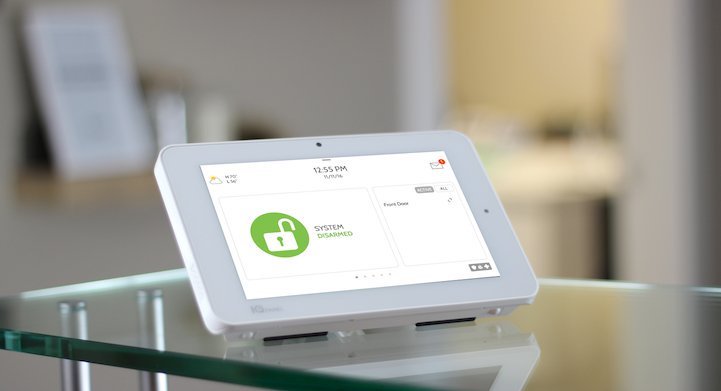When we work with customers to create a home security plan, we always start with a monitored burglar alarm system. These security systems provide multiple layers of security. For starters, activation of the alarm creates a blaring siren response. This alerts anyone at home to the danger, and often scares the thief away as well. Furthermore, a monitored alarm also sends out a message to our central station. In turn, this will create an emergency dispatch to address the event if necessary. Both of these features make adding this security extremely important. However, the alarm monitoring industry has changed quite a bit over the past couple decades due to the decline of the traditional home phone industry. In this post, we show you how we create alarm monitoring for cord-cutters.
First, we’ll explain how “traditional” monitoring works. This will give you a solid foundation for understanding the rest of the post. Then, we’ll explain some of the issues caused by phone-line based monitoring. From there, we’ll focus on some solutions to these issues. This section will include both network and cellular-based monitoring solutions. Now, let’s dive in with an overview of phone-line based alarm monitoring!
Your Traditional Alarm Monitoring Primer
Phone-based alarm monitoring represents the earliest form of connecting an alarm to our central station. This method involves tying a home’s existing phone lines into your new alarm system. In turn, an alarm activation creates a signal — transmitted over your phone line — that gets sent from your alarm straight to our central station. At this point, a central station operator attempts to contact you immediately to verify the existence of a real emergency. If they cannot contact you, they dispatch the proper authorities based on the type of signal that gets sent. This may include the police, the fire department, or even an ambulance. With this background in mind, let’s now turn our attention to the issues that arise when you depend on phone lines for alarm monitoring.

Traditional phone-line based monitoring creates issues that we’ve been able to address through more modern monitoring technology.
The Problems with Phone-Line Based Monitoring
While any form of alarm monitoring creates considerable security, traditional phone-based monitoring has its limitations. For starters, phone companies do not maintain their physical phone lines very well these days. After all, many homeowners have done away with having traditional phone service. Additionally, most customers now sign up for internet-based phone deals as part of cable bundles. It may surprise you to know that doing so does not actually give these customers a true phone line. Rather, it sets them up with inconsistent Voice over Internet Protocal (or “VoIP”) service. VoIP phones create a rather shaky experience for alarm customers, as we outline in our post explaining why VoIP is a Poor Choice for Alarm Systems.
In addition to phone line maintenance and VoIP-related issues, traditional alarm monitoring creates a couple other problems as well. For example, phone lines often fail due to inclement weather. This means that storms can interfere with your alarm monitoring. Furthermore, burglars often cut a home’s phone lines before attempting a break-in. Of course, this also negates your alarm’s connection with our central station. At this point, you should understand the basics — and the issues — behind traditional security monitoring. Next up, we turn our attention to creating effective monitoring for cord-cutters who wish to monitor their security system more reliably.
Alarm Monitoring You Can Count On
At this point, you have a basic understanding of both what alarm monitoring entails as well as the ways that traditional alarm monitoring can fail. Luckily, we have a couple ways that we can address these issues. In this section, we focus on the solutions that can solve the issues described in the previous section. Both of the solutions described here give you an option to bypass your phone lines entirely when setting up your alarm’s monitoring. Additionally, some customers still monitior their alarms through their phone lines, and set up these options as a “backup” in case the phone lines fail. Either way, the monitoring methods described here add consistent alarm monitoring for cord-cutters. Let’s start this discussion with a focus on network-based security monitoring.
Network-Based Monitoring
We’ve introduced network-based monitoring as a fairly new option for customers just over the last several years. This service allows you to use your home’s existing network, rather than a phone line, to monitor your security system. You have a couple different options to add this type of monitoring to their alarm. Many network-based monitoring customers purchase equipment that ties their alarm to their home’s internet service. Sometimes, this involves creating a hardwired connection between these devices and your home network. Other times, these devices allow a security sytem to connect to your wifi for your alarm monitoring.

The QOLSYS IQ Panel can connect to your internet via wifi for reliable monitoring without the need to purchase any additional equipment.
As an additional option, some security systems have the capability for network-based monitoring right out of the box. Select modern alarm panels, such as our preffered QOLSYS IQ Panel, come with the ability to connect to a network for monitoring with no additional equipment necessary! This allows you with reliable monitoring as efficiently as possible. Now, let’s show you how cellular dialers provide our most popular and effective form of alarm monitoring for cord-cutters.
Alarm Monitoring Through a Cellular Dialer
When we refer to a “cellular dialer,” we are referencing a piece of equipment that provides a direct communication path between your alarm and our central station. These dialers use a cellular network, rather than a phone line, for their communication. Moreover, we can also program cell dialers to communicate via a cell network and your home’s internet connection as a backup! This gives your alarm multiple chances to communicate over the quickest route available to call for help.
Furthermore, your cellular dialer can add convenience and security above and beyond providing a reliable communication path. In our post on Using Your Smartphone to Add Security to Your Alarm, we discussed the generational expectation that customers can control their electronics with their smartphones. Our interactive cell dialer powered by Alarm.com allows users to arm and disarm their security systems remotely using the Alarm.com smartphone app. It also allows them to receive notifications regarding security system status changes. These status updates can include low battery alerts, power failure notices, and other similarly important messages. This unique combination of additional security and convenience provided by interactive Alarm.com monitoring make it our most popular monitoring option!
Creating Effective Alarm Monitoring for Cord-Cutters
We hope that this post helps you understand how we can provide dependable alarm monitoring for cord-cutters. Moreover, we also encourage you to contact us with any questions the material here may present. We will happily answer any security-related inquiries you may have. Additionally, we also invite you to take advantage of our free site survey program. We offer complimentary security audits and equipment quotes to both new and existing customers alike. While on site, we can address any security concerns you may have. Furthermore, we can also make suggestions of our own based on the observations we make during our visit.
Perhaps you have a security system in place, but wish to cut the cord yourself and still keep your alarm monitored. Or, maybe you have yet to install a monitored alarm, and wish to do so with the most reliable monitoring in place right from the start. Either way, we are here to help! We have thirty-five years — and counting — of experience working with customers to create and install alarms that meet their security needs. Together, we can design a monitored alarm to keep your home, your most valued possessions, and your family as safe and secure as possible.
